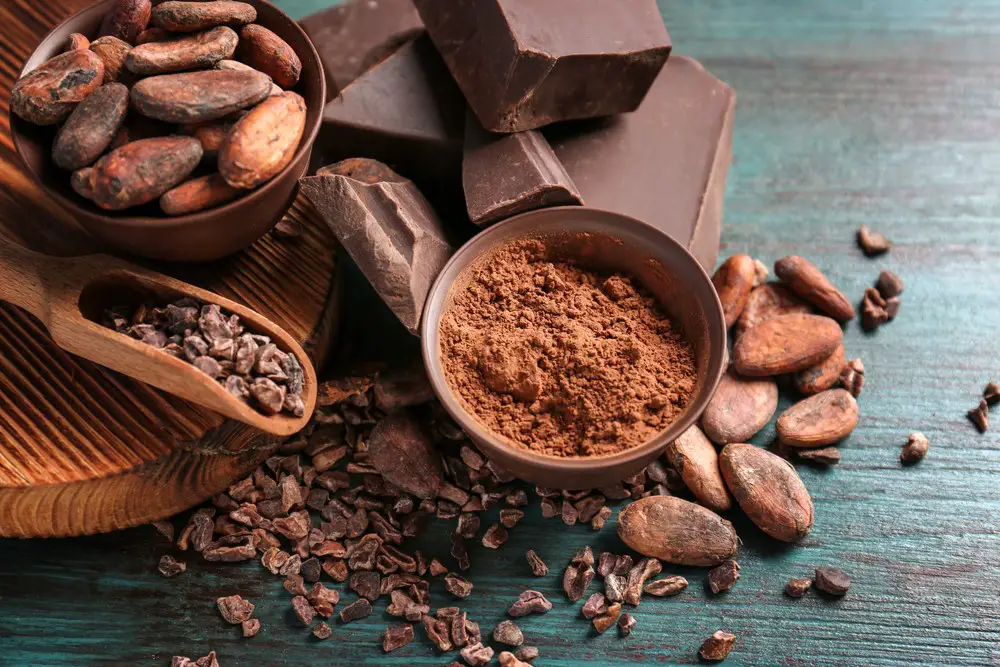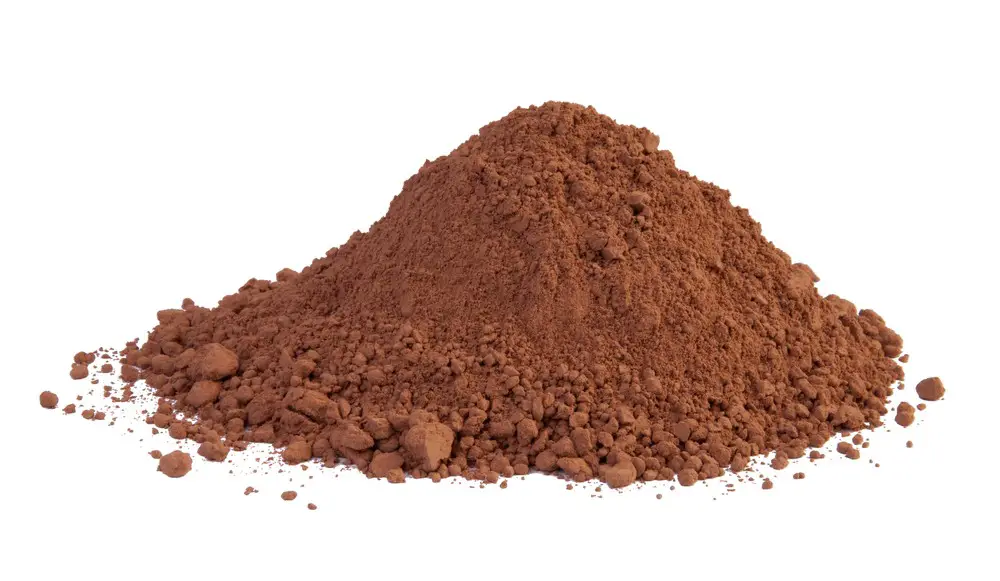Evidence of wide cocoa cultivation goes back at least 3,000 years. The cocoa tree is indigenous to the tropical forests of South and Central America. , The Olmecs formed a drink from cocoa by mixing it with spices, chilies, and water. Later, the Aztecs and Mayans developed successful cultivating methods.
Cocoa powder remains one of the world’s most prized ingredients for creating delicious confections and beverages. It’s a powerful ingredient full of nutritional benefits. But is cocoa powder vegan? While most chocolate is not vegan, pure cocoa powder is vegan.
Is Cocoa Powder Vegan?
The process for obtaining cocoa powder from cocoa beans does not use animal products. Harvesting of the cocoa bean requires great care to avoid damaging the pods. The growers extract, ferment, and roast the beans, ensuring a rich chocolatey flavor.
Once roasted, the next phase separates the hull from the nibs, preparing them for grinding. Mechanical pressing converts the nibs into chocolate liquor from which producers extract cocoa butter. Cocoa powder comes by grinding the resulting cake-like mass produced by this process. No animal products are used at any stage of the process, nor does it contain any animal products.
When is Cocoa Powder Not Vegan?
Turning a cocoa bean found on a cocoa tree into cocoa powder is vegan. However, some may mistake cocoa powder for chocolate powder, a completely different product.
Therefore, cocoa powder is vegan and dairy-free. It is also sugar-free, nut-free, and soy-free since it only contains cocoa solids and a trace of cocoa butter.
On the other hand, chocolate powder or hot cocoa mix usually contains cocoa, dehydrated milk, and sugar with several other ingredients. Therefore, these can’t be considered vegan.
Some brands make vegan cocoa mix options, including Ghirardelli, Godiva, and Sillycow Farms. Always check the ingredient list on the packaging before buying a product.

Types of Cocoa Powder
When choosing cocoa powder, you may wonder what all the terms you encounter mean. Here’s an explainer:
Dutch Process vs. Broma Process – Different brands use two main types of processing, the Dutch process and the Boma process (resulting in a natural cocoa powder). Brands mention this on their packaging so that you can tell which method they use.
Pure cocoa powder is acidic since its pH ranges from 5.3 to 5.8. Not only does its acidity level alter its flavor, it can also impact its ability to dissolver in liquids and how it interacts with other ingredients in a recipe.
If you prefer a cocoa powder that retains its natural pH level, choose a company that uses the Broma process. It will have an intense flavor and a lighter color. Then again, if you prefer a darker and sweeter cocoa powder, you should select a brand that uses the Dutch process, which involves bathing the beans in an alkaline solution to raise their pH levels. The cocoa powder remains vegan.
Its worth noting that the Dutch process reduces the flavanol levels in cocoa powder. Cocoa beans are rich in flavanols which are known for protecting cardiovascular health.
Red Cocoa Powder – Adding more alkali to the process produces a red cocoa powder. Once baked, the color does fade.
Black Cocoa Powder – Black cocoa powder contains the highest pH, giving it a color that resembles the color of Oreo biscuits. However, you cannot use it on its own because your baked goods will turn out crumbly and dry. Mix it with other cocoa powders to optimize its color and flavor.
Cacao Powder – This powder’s lighter color and flavor come because it’s the most natural state of cocoa since it’s not roasted. It also dries at low temperatures, maintaining a higher percentage of the plant’s nutrients and vitamins.
Learn more about the different types of cocoa in this World of Vegan article.

Cross-Contamination
When products are processed in facilities that also handle animal products, there is some cause for concern about cross-contamination. Therefore, a vegan product, cocoa powder, may come into contact with another animal product, like dairy or eggs.
Cross-contamination can also affect people with nut allergies. If you have an issue with either, buying a vegan-certified cocoa powder or choosing one without an allergy warning is best.
The best organic alternative is to buy a cacao powder produced with the Broma process.
Is Cocoa Powder Ethically Sourced?
Unfortunately, many companies have promised to help stop child labor while ensuring fair trade and protecting the environment but haven’t reached their goals.
For example, some of the major producers of chocolates cannot guarantee that their products contain cocoa powder free from child-free labor sources. Companies like Hershey, Mars, and Nestlé cannot trace much of their cocoa supply back to specific sources. The Vegan Foundry reports from the Washington Post that Nestlé can only trace 49% back to the farms that supply the cocoa nibs, while Hershey and Mars fare much worse.
These companies are not actively promoting child labor, but they also cannot actively trace it, especially in countries of West Africa where the problem is worse.
Many smaller companies have concentrated their efforts on ethically produced cocoa, where there’s no child labor involved, workers get fair wages, and farmers are aware of environmentally-friendly farming practices. However, ethical products do cost more, and these costs filter down to the consumer.

How to Identify Ethical Cocoa Powder?
Like other ethically sourced products, you must look for the fair-trade certificate on the packet. These companies also provide information about their entire supply chain on their websites, creating the transparency required to gain consumer trust.
A fair-trade certificate indicates a guaranteed minimum price paid for these commodities to ensure workers earn a fair wage for their labor. This minimum guaranteed price ensures that even if the market price of their commodity falls, they have a safety net to protect their income.
How to Use Cocoa Powder?
Use cocoa powder to make drinks, smoothies, cookies, brownies, and ice cream. You can also create lovely oatmeal breakfasts, muffins, cakes, and cupcakes.
Tips for Working with Cocoa Powder
- Use Dutch-processed cocoa powder in recipes that call for baking soda.
- For recipes that use baking powder, use a natural cocoa powder to balance the acidity of ingredients.
- Use a small amount of black cocoa powder mixed with regular cocoa powder to create an intense taste and color.
- Sift the cocoa before adding it to remove lumps when making hot chocolate or warm drinks.
- If you’re making a dark dessert like brownies, mix darker types of cocoa powder with lighter varieties to achieve a richer flavor and color without overpowering.
Final Take
Versatile cocoa powder is vegan and used in beverages, baking, toppings, and cosmetics. You can use cocoa powder to make your hot or cold chocolate beverages. Cocoa powder is the purest form of the cocoa bean and is a wholesome, powerful, and tasty ingredient that contains no sugar or fats. Therefore, cocoa powder is vegan, but don’t confuse it with chocolate powder.
Images Courtesy of DepositPhotos

